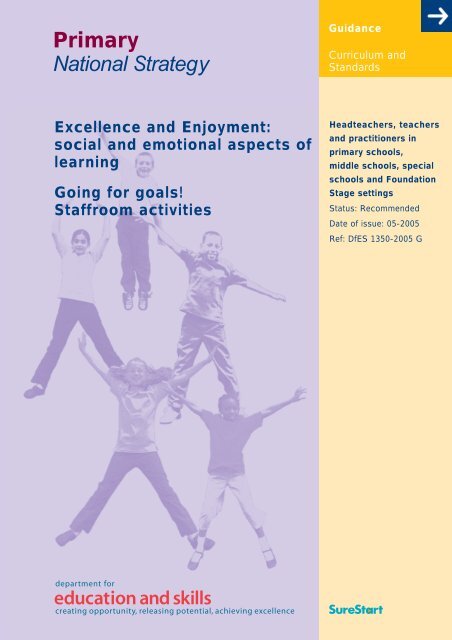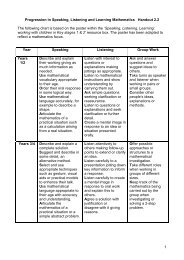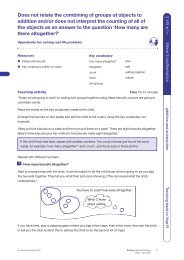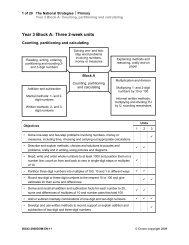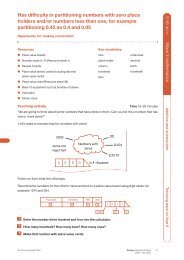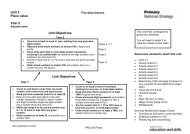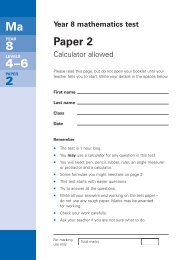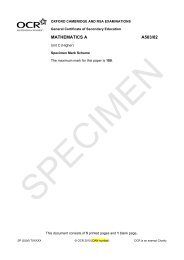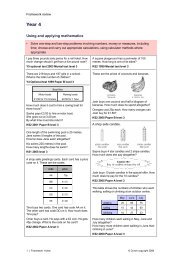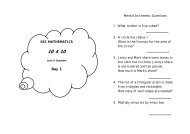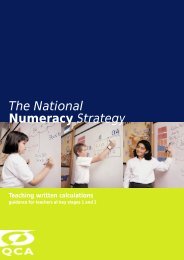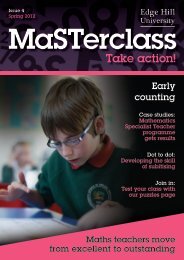Staff Room Activities
Staff Room Activities
Staff Room Activities
You also want an ePaper? Increase the reach of your titles
YUMPU automatically turns print PDFs into web optimized ePapers that Google loves.
PrimaryNational StrategyGuidanceCurriculum andStandardsExcellence and Enjoyment:social and emotional aspects oflearningGoing for goals!<strong>Staff</strong>room activitiesHeadteachers, teachersand practitioners inprimary schools,middle schools, specialschools and FoundationStage settingsStatus: RecommendedDate of issue: 05-2005Ref: DfES 1350-2005 G
DisclaimerThe Department for Education and Skills wishes to make it clear that the Department andits agents accept no responsibility for the actual content of any materials suggested asinformation sources in this document, whether these are in the form of printed publicationsor on a website.In these materials icons, logos, software products and websites are used for contextual andpractical reasons. Their use should not be interpreted as an endorsement of particularcompanies or their products.The websites referred to in these materials existed at the time of going to print. Usersshould check all website references carefully to see if they have changed and substituteother references where appropriate.
Purple setGoing for goals! – activites for the staff roomIntroductionThe following activities are designed to be carried out in the staff room to help adults totune in to the strands of the theme at an adult level, and to experience at first hand someoff the activities that the children will be engaging with at different stages.These activities are designed to help you as a staff group to think about the issues involvedin working with children on how we motivate ourselves, how to reach goals and how to bean effective learner.The key ideas and concepts behind the Going for goals! theme are:MotivationThis involves encouraging learners to be able to set a goal, break a long-term goal intosmall steps, be persistent through a range of strategies, realise when they have met theirgoal and review the effectiveness of what they have done.Knowing and understanding ourselves as a learnerIn order to remain well motivated we need to be self-aware in the area of learning. Thistheme provides several opportunities for children to consider how they learn best and theconditions they need for learning.This theme draws on the work of Howard Gardner on multiple intelligences to help childrento consider the question ‘How am I clever?’ (rather than the more usual question, ‘Howclever am I?’). It also provides an opportunity for children to consider their particularstrengths in learning by seeing, doing or talking and listening.Problem solving and making wise choicesThe problem-solving process is considered more fully in this theme as a way ofencouraging children to make choices about their actions.In Key Stage 2 children are provided with opportunities to help them make wise choices.The materials encourage children to think about practical aspects (for example usingprediction, considering probable likelihood of success), the effect their choice might haveon themselves and their own feelings, the feelings of other individuals involved and thevarious communities of people their choice will impact on.Solution-focused approachesThe materials use ideas from ‘solution-focused’ methodology to encourage children withgoal setting and planning to reach a goal.This theme’s core focus is on motivation and staff who are using the Excellence andEnjoyment: learning and teaching in the primary years materials (DfES 0518-2004 G) mightalso want to draw on the activities in the Conditions for Learning booklet (pp. 26–30) andLearning to Learn: progression in key aspects of learning booklet (pp. 46–49).1© Crown copyright 2005 Going for goals! <strong>Staff</strong>room activitiesDfES 1350-2005Primary National Strategy
What to doRate yourself according to how frequently you use the strategies in the table.Strategy seldom oftenShow a personal enjoyment, interest and enjoyment in the 1 2 3 4 5 6 7 8 9 10content of the lesson.Place an emphasis on how children learn rather than their 1 2 3 4 5 6 7 8 9 10performance.Encourage autonomy in the children. 1 2 3 4 5 6 7 8 9 10Focus on individual improvement and what has been learned 1 2 3 4 5 6 7 8 9 10rather than making judgements or comparisons.Emphasise progress over time rather than grades or marks. 1 2 3 4 5 6 7 8 9 10Provide informative feedback that helps the child feel responsible 1 2 3 4 5 6 7 8 9 10for their success and helps them improve.Attribute failure to the nature of the task, quality of teaching 1 2 3 4 5 6 7 8 9 10or some changeable aspect of the child.Make it clear that mistakes are a valuable part of learning. 1 2 3 4 5 6 7 8 9 10Talk to a partner and give examples to show why you have rated yourself in the way youhave.Applying learningIn pairs, choose one or two of the aspects and decide a practical step that you might taketo move one step towards the right-hand side of the scale and use more strategies toencourage internal motivation. With your partner, discuss how you are going to support,encourage and motivate each other as you try out your ideas.Activity 3: keeping going when things get toughLearning is not easy and when we are learning or doing a difficult or repetitive task weoften get bored, frustrated or just stuck. The materials look at the area of persistence inmost year group sets.ResourcesMaterials to make a staffroom posterWhat to doIndividually or in pairs, spend a minute thinking about the last task that you did when youfound it hard to keep going. (This might be writing reports for parents, completing an essayfor a course, doing the ironing, raking the leaves.)Thought shower: What was motivating you? What strategies did you use to keep going?Your ideas will probably include some or all of these strategies – setting yourself a rewardfor completing the task, setting yourself a time challenge, breaking down the task and 3© Crown copyright 2005 Going for goals! <strong>Staff</strong>room activitiesDfES 1350-2005Primary National Strategy
setting time scales for each bit, breaking down the task and promising yourself a rewardfor completing each chunk, having a break, doing something completely different, sleepingon it, walking around, visualising or thinking about what it will be like when the task isfinished, asking others to help, talking through what you are doing, receiving feedback fromothers.When you have finished, create a staffroom poster of your favoured ways to keep going.Applying learningComplete the task with the children in your class and create your own classroom poster. Itwill be interesting to consider how you might accommodate some of the strategies thechildren may suggest (such as walking around, having a break, doing somethingcompletely different or working towards a reward).As a whole staff or phase group, you might also agree to consider with your class what todo when you are stuck. Children might agree five key actions before they ask an adult forhelp. These might be put on the wall or on each child’s table.Activity 4: encouraging autonomyWhat to doThis activity is best carried out in phase groups. Consider the questions:• What choices did the children in our class make for themselves today/yesterday?• How many ways do we encourage autonomy in our classrooms?• What ideas can you think of that will encourage autonomy? Think creatively and includeall the ideas you can think of (even those that seem impractical).Compare the lists each phase group has come up with.Applying learningUse an additional strategy each week. Review progress.Activity 5: knowing ourselves as a learner (1)ResourcesA copy for each person of the resource sheet How am I clever? (From the Yellow set: Year 3).Teachers’ planning filesWhat to doThere are many ways of categorising the way we are as a learner. As a school you mightalready have adopted a particular approach. The advantages of using one or more of theseapproaches is to help us provide a rich learning environment for all children, encouragingthem to use all their senses and learning styles to the fullest extent. The danger is that welabel children and so reduce opportunities and expectations.4Going for goals! <strong>Staff</strong>room activities © Crown copyright 2005Primary National Strategy DfES 1350-2005
The materials in this theme use two main approaches to learning style. Firstly whenencouraging children to consider ‘How am I clever?’ rather than ‘How clever am I?’ theydraw on the ideas of Howard Gardner and his theories of multiple intelligence.These approaches are not the only way of considering learning style or ‘intelligence’. If youlook on the Internet you will find other approaches. You will also find some onlinequestionnaires to find out about your own learning styles and intelligences. It can be fun totry these out.Use the resource sheet How am I clever?. In pairs, examine your planning for the comingweek. How many intelligences does it cater for? Can you make sure that over the weekyou plan activities that meet the needs of children with all the different intelligences?Applying learningShare your plans with your colleagues. Try out any new ideas with your classes and reportback at a future meeting.Activity 6: knowing ourselves as a learner (2)What to doThe second approach used in the materials for this theme is to encourage children toconsider whether they enjoy learning by seeing (visual learning), talking (verbal learning) orby touching/doing (kinaesthetic learning).As staff, you may already have worked together on visual, auditory and kinaestheticlearning. If you have not, you may want to think back over the week. Consider the learningopportunities you planned. What types of learning styles did they cater for? Which teachingstyle are you most likely to use?Work in small groups, asking for suggestions about learning opportunities you couldintroduce that draw on your least used style.Applying learningTry these suggestions in the classroom and report back at a future meeting.Activity 7: qualities of a good learnerResourcesA copy of The fourth son story from the Green set resource sheets: Year 5.What to doRead the story The fourth son. When you have finished you might like to use a communityof enquiry, if you are familiar with this approach, or you might discuss the followingquestions.• Which son had been given the most useful present from the spirit? Why?• What would be written on the six stones? Remember, the pebbles are small and onlyone or two words can be written on each.5© Crown copyright 2005 Going for goals! <strong>Staff</strong>room activitiesDfES 1350-2005Primary National Strategy
You might like to look at the work of others and use one of their frameworks to extend anddevelop your own ideas. Examples of published models available on line are the Campaignfor Learning’s 5Rs (www.campaign-for-learning.org.uk) or Guy Claxton’s 4Rs(www.buildinglearningpower.co.uk).You might also watch video clip 1 from ‘Learning to learn: progression in key aspects oflearning’ from Excellence and Enjoyment: learning and teaching in the primary years (DfES0518-2004 G).How good a learner are you? Rate yourself with a scale of 1 to 10 against the ‘learning tolearn’ qualities or skills you have decided on.Applying learningDecide on strategies you can use with the children to promote the learning to learnqualities or skills you have identified. Try out your ideas in the classroom.All staff might like to work with the children to identify the learning to learn qualities theythink are important. Children might use these to help them reflect on their learning and planto become a better learner.Activity 8: problem-solving strategyResourcesA copy of the Problem-solving strategy poster from the whole-school resource file.What to doThis activity can be done in small groups (possibly phase groups) or as a whole staff.Individually or in pairs, first consider any problems that really rile and irritate you at school.This might be a particular time in the school day or it might relate to a group of childrenand how they behave. Take a little time to share your problems before choosing one to useto practise the problem-solving strategy together.Example of a problemIn my class things always seem to go wrong at the beginning of the day. Thechildren are slow to settle and I seem to have to tell them off. This starts the daybadly when I really want to have a pleasant start.Use the problem-solving strategy to come up with the best possible solution.Applying learningTry out your solution and report back at a later meeting.6Going for goals! <strong>Staff</strong>room activities © Crown copyright 2005Primary National Strategy DfES 1350-2005
Activity 9: using solution-focused approachesResourcesPaper and pensWhat to doThis activity will provide you with a taster of solution-focused approaches. These are verypowerful in helping children and adults make changes in their lives and you might like toresearch them further.Solution-focused thinking originated as a therapeutic approach but has been developed foruse in a wide variety of ways and settings. For example, solution-focused coaching usesthe approach when supporting teachers and other professionals develop their practice.Solution-focused approaches are often used in work with children who need extra help todevelop their social, emotional and behavioural skills. You can find out more in theFocusing on solutions: a positive approach to managing behaviour (DfES 0759-2003)session from the Primary National Strategy behaviour and attendance professionaldevelopment materials (available from www.standards.dfes.gov.uk/primary/wholeschoool/banda).The curriculum materials in this theme use two particular solution-focused strategies. Youmight like to try these out using one of the problems identified in Activity 8.Approach 1: preferred futuresRead out the following:Suppose tonight when you are asleep a miracle happens and the problem nolonger exists. You don’t know immediately it has happened because you areasleep. When you wake up, what is the first thing that will let you know there hasbeen a miracle?Try to elicit as rich a picture as possible of the ‘miracle’ (the preferred future). You mightuse questions like:• What would you see and hear?• What would you be doing?• Would you know the miracle has happened?• Who else would know the miracle had happened?• Who would be the first person to notice what had happened?• How would you walk into the staff room?• What would the class notice about you when they first meet you?• What else would they notice?• What would your classroom look like?• How would you walk around the classroom?• What would you say to the class that would let them know that things were different?• What else would you say or do?7© Crown copyright 2005 Going for goals! <strong>Staff</strong>room activitiesDfES 1350-2005Primary National Strategy
Approach 2: scalingAsk each person to draw a scale of 0 to 10 and read out the following:If you consider that your miracle day was 10 on a scale of 0 to 10, and when theproblem was at its very worst it was 0 on this scale, where do you think you are inrelation to the problem today?Each person indicates where they are. Then use the following questions to encouragethem to find solutions to the problem and to set themselves targets.For example:• What will tell you that you have moved one point up the scale (what will you hear, see,be doing)?• So what is it you are doing that means you are at 4 and not 3?• Where on the scale represents where you want to get?What would you be doing then?• What will be the first sign that things are different?• What will you be doing then that you are not doing now?• What is stopping things getting worse?• What one thing might you do that will help you move one point up the scale? (one moreon the scale than today)Activity 10: making wise choicesThe idea behind making wise choices extends the use of the problem-solving process intoa more detailed and thoughtful exploration of the consequences of a particular course ofaction.A wise choice is one that balances the practical or thinking elements of the process with adetailed exploration of the intrapersonal (relating to myself and my feelings), theinterpersonal (relating to the needs of other individuals involved) and extrapersonal (relatingto the needs of the communities involved).The following activity from Green set starts to explore this idea.Read the story of Paramjeet.8Going for goals! <strong>Staff</strong>room activities © Crown copyright 2005Primary National Strategy DfES 1350-2005
Pauline’s new watch had gone missing from her bag. What a disaster! The classhad been kept in while Mrs Brown had asked them to search for it. She went outof the room while they did this and said, ‘I hope it is on my desk when I get back.’Everyone looked for it, but it didn’t turn up. Mrs Brown said how disappointed shewas and that she would have to phone Pauline’s parents to explain. She lookedreally angry and disappointed.Paramjeet ran out of school. He had to hurry because he was going away with hisfamily for his cousin’s wedding. There was only one train and they couldn’t missit. He was nearly home. He just had time to buy some sweets for the long journey.He went into the corner shop. He reached into the special compartment in his bagto get out the money and he felt it – Pauline’s watch. He and Pauline hadidentical bags. She must have put the watch in his bag by mistake.What would be the wisest thing for Paramjeet to do?Talk together for a couple of minutes in pairs, to explore your initial ideas and record themin some way.As a group, use the steps outlined below to come up with the wisest choice.Ready:Is Paramjeet calm enough to think? How might Paramjeet calm down?Steady:1 How was he feeling?2 What is the problem? Why is this a problem?3 What does he want to happen?4 Think of all the possible options. Be as creative as you can.Are they practical? How likely are they to be successful?5 Choose two or three to explore further.What would happen if he did these?6 Who does he need to think about?(Pauline, Mrs Brown, his parents, his sister, himself)7 What groups (communities) of people does he need to think about?(his family, his class)8 Plan - what he should do first, what he should do next, and so on.Applying learningDiscuss:how you might apply this to the choices children have to make in school;how you might apply this to the choices you make as a staff at school.9© Crown copyright 2005 Going for goals! <strong>Staff</strong>room activitiesDfES 1350-2005Primary National Strategy
Copies of this document may be available from:DfES PublicationsTel: 0845 60 222 60Fax: 0845 60 333 60Textphone: 0845 60 555 60e-mail: dfes@prolog.uk.comRef: DfES 1350-2005 G© Crown copyright 2005Produced by theDepartment for Education and Skillswww.dfes.gov.ukIf this is not available in hard copy it can bedownloaded from:www.standards.dfes.gov.ukThe content of this publication may be reproducedfree of charge by schools and local educationauthorities provided that the material isacknowledged as Crown copyright, the publicationtitle is specified, it is reproduced accurately and notused in a misleading context. Anyone else wishingto reuse part or all of the content of this publicationshould apply to HMSO for a core licence.The permission to reproduce Crown copyrightprotected material does not extend to anymaterial in this publication which is identifiedas being the copyright of a third party.Applications to reproduce the material from thispublication should be addressed to:HMSO, The Licensing Division, St Clements House2-16 Colegate, Norwich NR3 1BQFax: 01603 723000e-mail: hmsolicensing@cabinet-office.x.gsi.gov.ukOUP 05-2005


